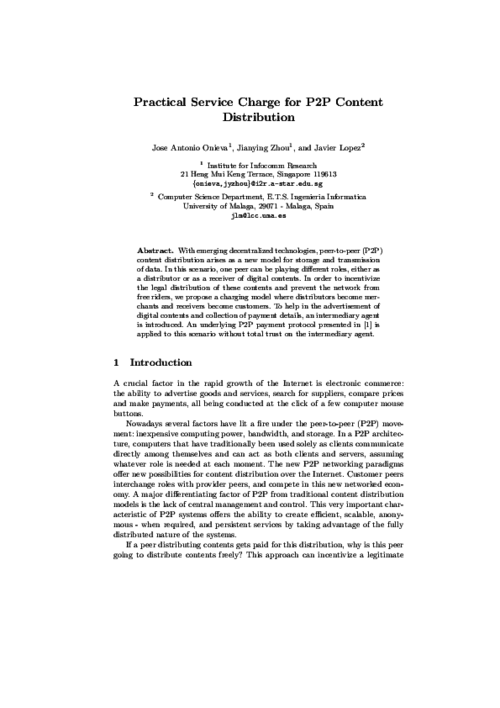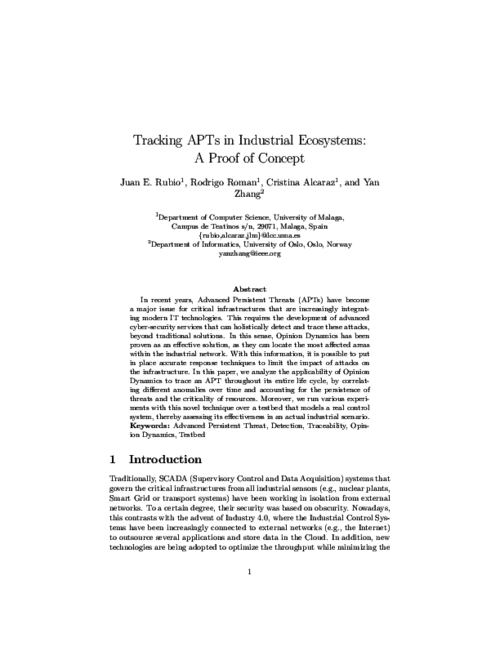 ]
] Journal of Computer Security, vol. 27, issue 5, Elsevier, pp. 521-546, 09/2019.
European Symposium on Research in Computer Security (ESORICS 2018), vol. 11098, Springer, pp. 555-574, 08/2018. DOI
Abstract
Advanced persistent threats pose a serious issue for modern industrial environments, due to their targeted and complex attack vectors that are difficult to detect. This is especially severe in critical infrastructures that are accelerating the integration of IT technologies. It is then essential to further develop effective monitoring and response systems that ensure the continuity of business to face the arising set of cyber-security threats. In this paper, we study the practical applicability of a novel technique based on opinion dynamics, that permits to trace the attack throughout all its stages along the network by correlating different anomalies measured over time, thereby taking the persistence of threats and the criticality of resources into consideration. The resulting information is of essential importance to monitor the overall health of the control system and correspondingly deploy accurate response procedures.
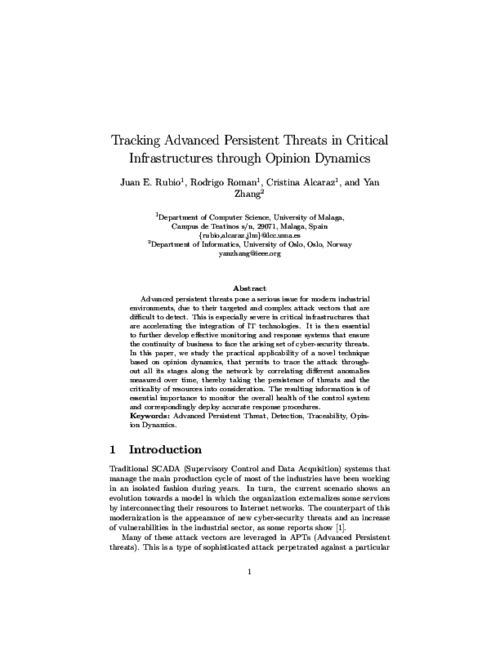
International Journal of Critical Infrastructure Protection (IJCIP), vol. 8, Elsevier Science, pp. 53–66, 01/2015. DOI
Abstract
Critical infrastructures play a vital role in supporting modern society. The reliability, performance, continuous operation, safety, maintenance and protection of critical infrastructures are national priorities for countries around the world. This paper explores the vulnerabilities and threats facing modern critical infrastructures with special emphasis on industrial control systems, and describes a number of protection measures. The paper also discusses some of the challenging areas related to critical infrastructure protection such as governance and security management, secure network architectures, self-healing, modeling and simulation, wide-area situational awareness, forensics and learning, and trust management and privacy.
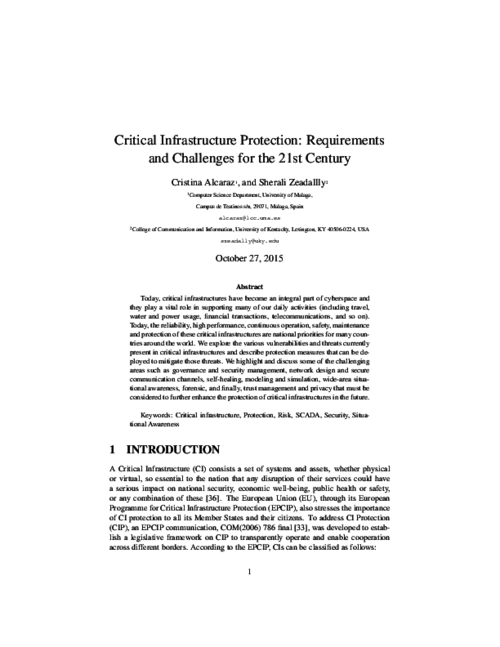
IEEE Computer, vol. 46, no. 10, IEEE Computer Society, pp. 74 - 83, 2013. DOI
Abstract
Information systems, networks, and technologies have become an integral part of modern critical control systems that manage many of today’s critical infrastructures. The continuous operation, maintenance, and protection of critical infrastructures have become a high national priority for governments around the world because our society heavily depends on them for most of our daily activities (travel, power usage, banking transactions, telecommunications, etc) and safety. It is therefore critical that these infrastructures have to be protected from potential accidental incidents or cyberattacks. We present the fundamental architectural components of critical control systems which manage most critical infrastructures. We identify some of the vulnerabilities and threats to modern critical control systems followed by protection solutions that can be deployed to mitigate attacks exploiting these vulnerabilities.
Computer Networks, vol. 57, Elsevier, pp. 2266–2279, July 2013. DOI
Abstract
In the Internet of Things, services can be provisioned using centralized architectures, where central entities acquire, process, and provide information. Alternatively, distributed architectures, where entities at the edge of the network exchange information and collaborate with each other in a dynamic way, can also be used. In order to understand the applicability and viability of this distributed approach, it is necessary to know its advantages and disadvantages – not only in terms of features but also in terms of security and privacy challenges. The purpose of this paper is to show that the distributed approach has various challenges that need to be solved, but also various interesting properties and strengths.
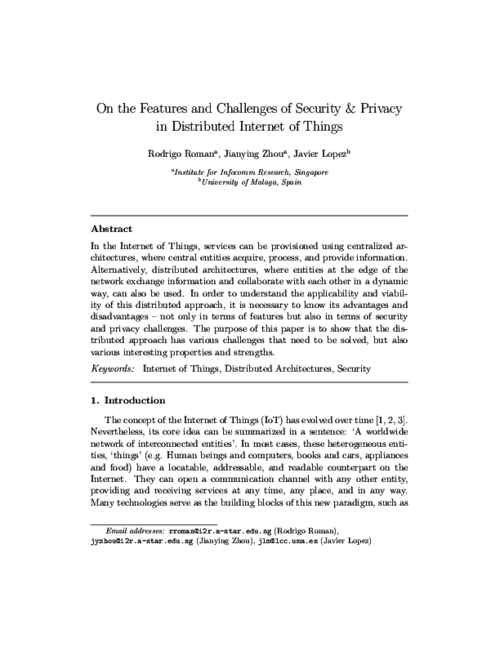
XII Reunión Española sobre Criptología y Seguridad de la Información (RECSI 2012), U.. Zurutuza, R.. Uribeetxeberria, and I.. Arenaza-Nuño Eds., pp. 309-314, Sep 2012.
Abstract
Los patrones de tráfico característicos de las redes inalámbricas de sensores (WSNs) dan lugar al problema de la privacidad de localización. De manera similar, el tráfico de los usuarios en Internet revela información sensible que puede ser protegida mediante sistemas de comunicación anónima (ACS). Por ello, este trabajo analiza la posibilidad de adaptar las soluciones de anonimato tradicionales al problema particular de las redes de sensores. Hasta el momento estas soluciones habían sido rechazadas sin un análisis riguroso, argumentando simplemente que eran demasiado exigentes computacionalmente para los nodos sensores. Nuestros resultados demuestran que, en general, algunos ACS no cumplen los requisitos de privacidad necesarios en WSNs mientras que otros, que si los cumplen, se valen de una cantidad de recursos que superan la capacidad de los sensores.

|
"Proceedings of the 4th International Symposium on Cyberspace Safety and Security (CSS 2012)", 4th International Symposium on Cyberspace Safety and Security (CSS 2012), vol. LNCS, Springer, Dec 2012.  |  |
21st International Conference on Computer Communications and Networks (ICCCN), IEEE Computer Society, pp. 1-5, Jul 2012. DOI
Abstract
Migration to an electronically controlled electrical grid to transmit, distribute, and deliver power to consumers has helped enhance the reliability and efficiency of conventional electricity systems. At the same time, this digitally enabled technology called the Smart Grid has brought new challenges to businesses and consumers alike. A key component of such a grid is the smart-metering technology, which is used to collect energy consumption data from homes and transmitting it back to power distributors. A crucial concern is the privacy related to the collection and use of energy consumption data. We present an analysis of Smart Grid privacy issues and discuss recently proposed solutions that can protect the privacy of Smart Grid users.
Wireless Personal Communications, vol. 73, Springer, pp. 23-50, Nov 2013, 2012. DOI
Abstract
The smart grid is an electronically controlled electrical grid that connects power generation, transmission, distribution, and consumers using information communication technologies. One of the key characteristics of the smart grid is its support for bi-directional information flow between the consumer of electricity and the utility provider. This two-way interaction allows electricity to be generated in real-time based on consumers’ demands and power requests. As a result, consumer privacy becomes an important concern when collecting energy usage data with the deployment and adoption of smart grid technologies. To protect such sensitive information it is imperative that privacy protection mechanisms be used to protect the privacy of smart grid users. We present an analysis of recently proposed smart grid privacy solutions and identify their strengths and weaknesses in terms of their implementation complexity, efficiency, robustness, and simplicity.
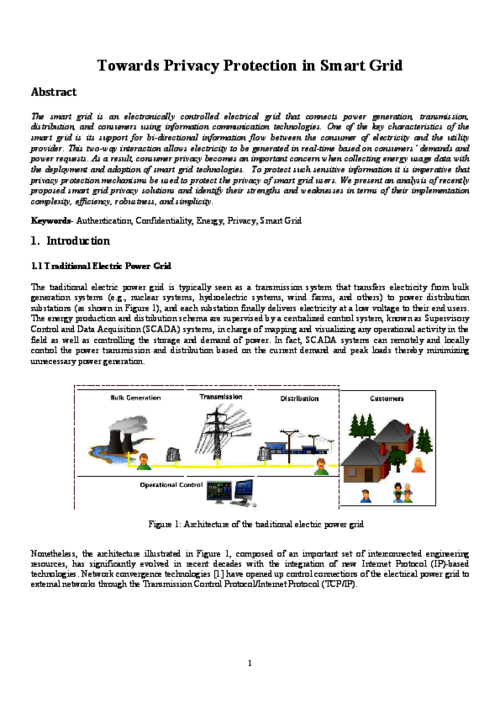
IEEE 16th Conference on Emerging Technologies Factory Automation (ETFA 2011), IEEE, pp. 1-10, Sep 2011. DOI
Abstract
Today we live in an environment surrounded with networked converging devices. Human computer interactions are becoming personalized and a new concept of a global and cross-domain platform is emerging to exploit the full potential of the network in all business areas. In this convergence process, the software platform should be able to personalize itself dynamically in devices according to the context. OSAmI-Commons, an ITEA2 project for developing an open-source common approach to such a dynamic service-based platform, allows any type of device to connect and exchange information and services. OSAMI consortium is contributing to defining the foundations of a cross-platform open-services ecosystem. The sustainability of this platform is an objective beyond the project duration.
Concurrency and Computation Practice & Experience, vol. 23, no. 12, John Wiley & Sons, Inc., pp. 1414-1430, Aug 2011. DOI
Abstract
Energy distribution systems are becoming increasingly widespread in today’s society. One of the elements that is used to monitor and control these systems are the SCADA (Supervisory Control and Data Acquisition) systems. In particular, these control systems and their complexities, together with the emerging use of the Internet and wireless technologies, bring new challenges that must be carefully considered. Examples of such challenges are the particular bene¯ts of the integration of those new technologies, and also the e®ects they may have on the overall SCADA security. The main task of this paper is to provide a framework that shows how the integration of di®erent state-of-the-art technologies in an energy control system, such as Wireless Sensor Networks (WSNs), Mobile Ad-Hoc Networks (MANETs), and the Internet, can bring some interesting benefits such as status management and anomaly prevention, while maintaining the security of the whole system.
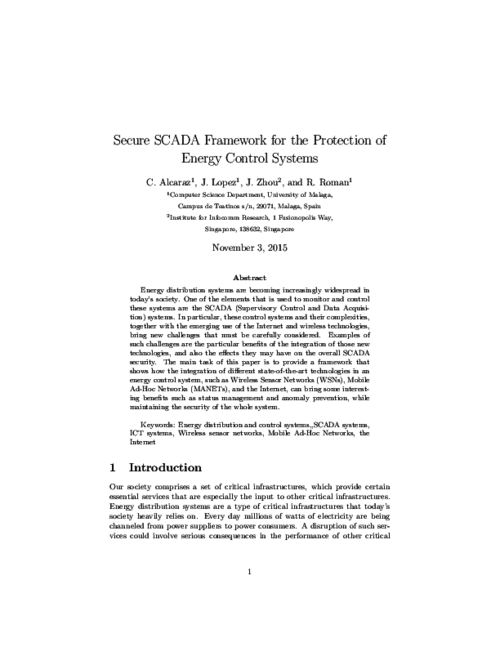
Sensors, vol. 10, pp. 3718-3731, 2010.
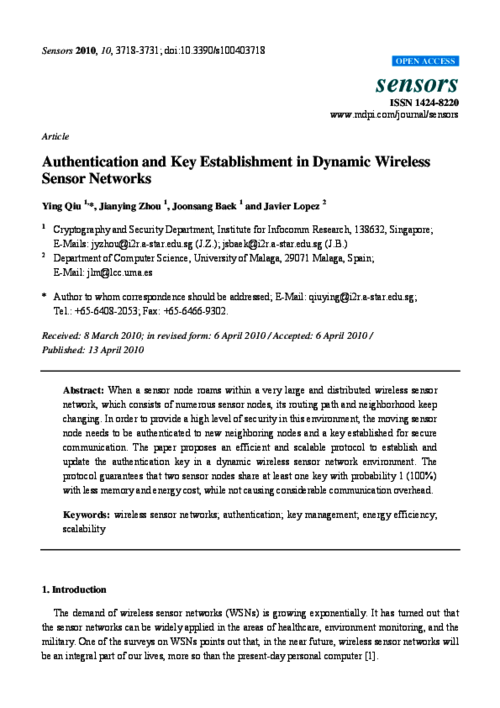
3rd International Conference on Network and System Security (NSS 2009), IEEE Computer Sociaty, OCT 2009.
|
"Secure Multi-Party Non-Repudiation Protocols and Applications", Advances in Information Security, vol. 43, Springer, 2009. 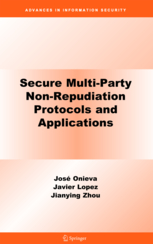 |  |
23rd International Information Security Conference (SEC 2008), vol. 278, pp. 125-139, 2008.
Wireless Sensor Network Security, J. Lopez, and J. Zhou Eds., IOS Press, 2008.
Abstract
Security has been proven a crucial factor in the provision of data services and especially in the computer-related environments. While wired and wireless networks come to all sectors of everyday life, security tries to satisfy the growing needs for confidentiality, integrity and non-repudiation. There are many instances of security primitives and each one of them has different requirements in terms of processing power, word size, etc. Therefore, it is important to review the functionality of the less resource-demanding encryption algorithms in order to analyze their theoretical suitability to the existent sensor node hardware. Still, the constraints inherent to the sensor nodes advise against the total dependence on software-based implementations, even more in the case of expensive primitives.
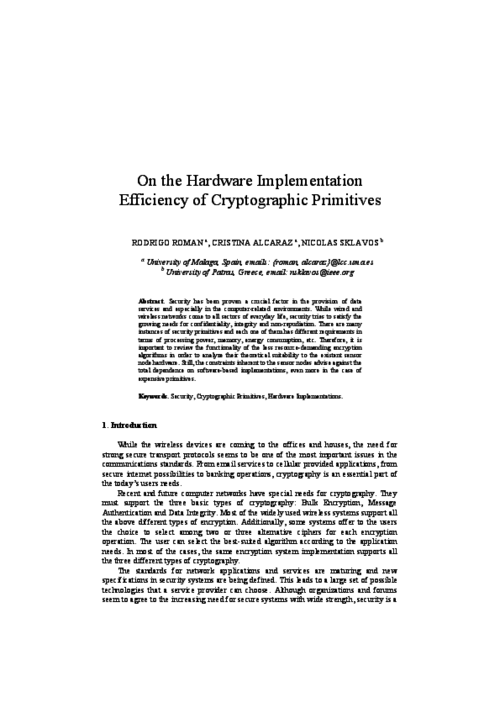
ACM Comput. Surveys, vol. 41, no. 1, pp. 5, December, 2008.
Abstract
Nonrepudiation is a security service that plays an important role in many Internet applications. Traditional two-party nonrepudiation has been studied intensively in the literature. This survey focuses on multiparty scenarios and provides a comprehensive overview. It starts with a brief introduction of fundamental issues on nonrepudiation, including the types of nonrepudiation service and cryptographic evidence, the roles of trusted third-party, nonrepudiation phases and requirements, and the status of standardization. Then it describes the general multiparty nonrepudiation problem, and analyzes state-of-the-art mechanisms. After this, it presents in more detail the 1-N multiparty nonrepudiation solutions for distribution of different messages to multiple recipients. Finally, it discusses advanced solutions for two typical multiparty nonrepudiation applications, namely, multiparty certified email and multiparty contract signing.
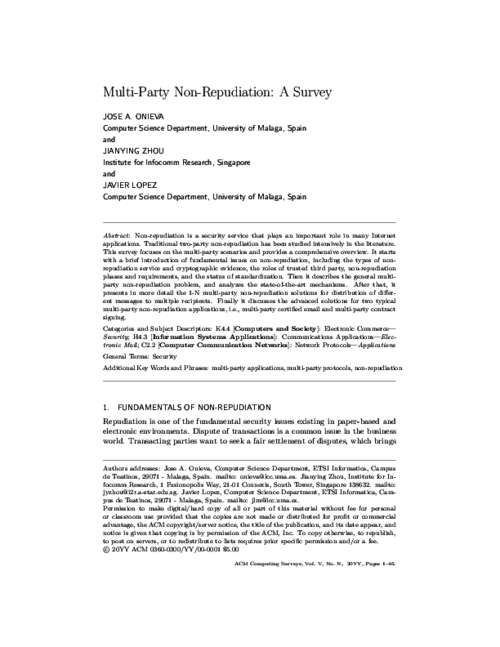
|
"Wireless Sensor Networks Security", Cryptology and Information Security Series, vol. 1, IOS Press, 2008.  |  |
Information Security Technical Report, vol. 12, no. 3, Elsevier, pp. 179-185, 2007. DOI
Abstract
Spam is a big problem for email users. The battle between spamming and anti-spamming technologies has been going on for many years. Though many advanced anti-spamming technologies are progressing significantly, spam is still able to bombard many email users. The problem worsens when some anti-spamming methods unintentionally filtered legitimate emails instead! In this paper, we first review existing anti-spam technologies, then propose a layered defense framework using a combination of anti-spamming methods. Under this framework, the server-level defense is targeted for common spam while the client-level defense further filters specific spam for individual users. This layered structure improves on filtering accuracy and yet reduces the number of false positives. A sub-system using our pre-challenge method is implemented as an add-on in Microsoft Outlook 2002. In addition, we extend our client-based pre-challenge method to a domain-based solution thus further reducing the individual email users’ overheads.
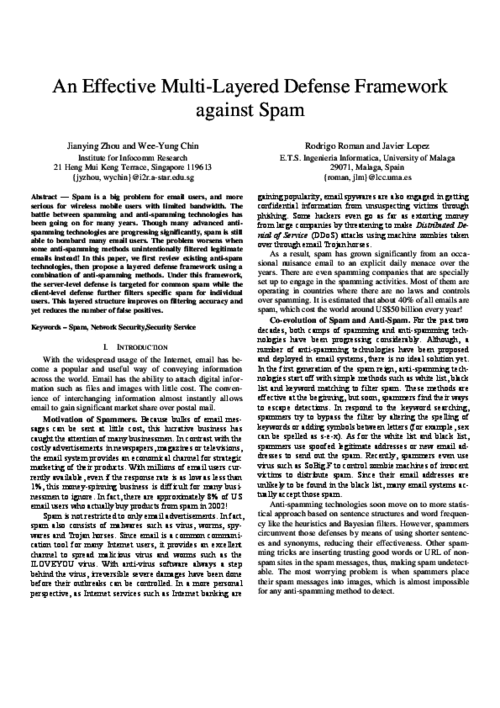
7th International Conference on Computational Science and Its Applications (ICCSA’07), LNCS 4706, Springer, pp. 549-558, 2007.
Abstract
In order to achieve a high performance in a real implementation of the non-repudiation service it is necessary to estimate timeouts, TTP features, publication key time, number of originators and recipients, and other relevant parameters. An initial work of the authors focused on a basic event-oriented simulation model for the estimation of timeouts. In the actual work, we present a set of extensions to that basic model for the estimation of the TTP features (storage capacity and ftp connection capacity). We present and analyze the new and valuable results obtained.
Telecommunications Systems, vol. 35, pp. 161-176, September, 2007.
Abstract
In any kind of electronic transaction, it is extremely important to assure that any of the parties involved can not deny their participation in the information exchange. This security property, which is called non-repudiation, becomes more important in Digital Rights Management (DRM) scenarios, where a consumer can freely access to certain contents but needs to obtain the proper Right Object (RO) from a vendor in order to process it. Any breach in this process could result on financial loss for any peer, thus it is necessary to provide a service that allows the creation of trusted evidence. Unfortunately, non-repudiation services has not been included so far in DRM specifications due to practical issues and the type of content distributed. In this paper we analyze how to allow the integration of non-repudiation services to a DRM framework, providing a set of protocols that allows the right objects acquisition to be undeniable, alongside with a proof-of-concept implementation and a validation process.
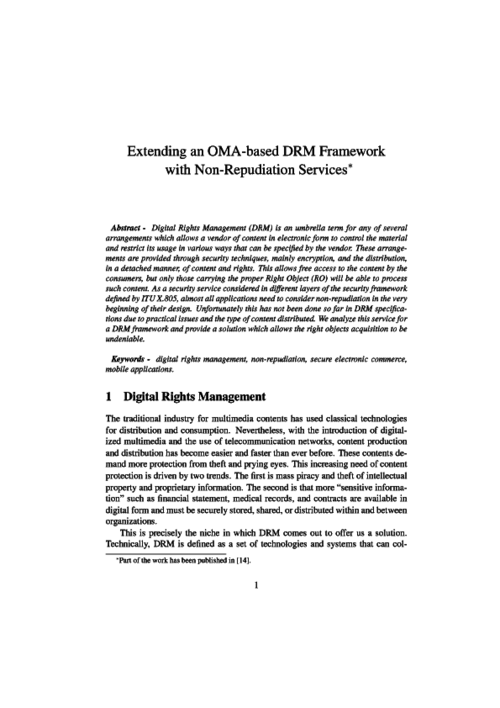
Computer Communications, vol. 29, no. 15, Elsevier, pp. 2739-2749, 2006. DOI
Abstract
Unsolicited Commercial Email, or Spam, is nowadays an increasingly serious problem to email users. A number of anti-spam schemes have been proposed in the literature and some of them have been deployed in email systems, but the problem has yet been well addressed. One of those schemes is challenge-response, in which a challenge, ranging from a simple mathematical problem to a hard-AI problem, is imposed on an email sender in order to forbid machine-based spam reaching receivers’ mailboxes. However, such a scheme introduces new problems for the users, e.g., delay of service and denial of service. In this paper, we introduce the pre-challenge scheme, which is based on the challenge-response mechanism and takes advantage of some features of email systems. It assumes each user has a challenge that is defined by the user himself/herself and associated with his/her email address, in such a way that an email sender can simultaneously retrieve a new receiver’s email address and challenge before sending an email in the first contact. Some new mechanisms are employed in our scheme to reach a good balance between security against spam and convenience to normal email users. Our scheme can be also used for protecting other messaging systems, like Instant Messaging and Blog comments.
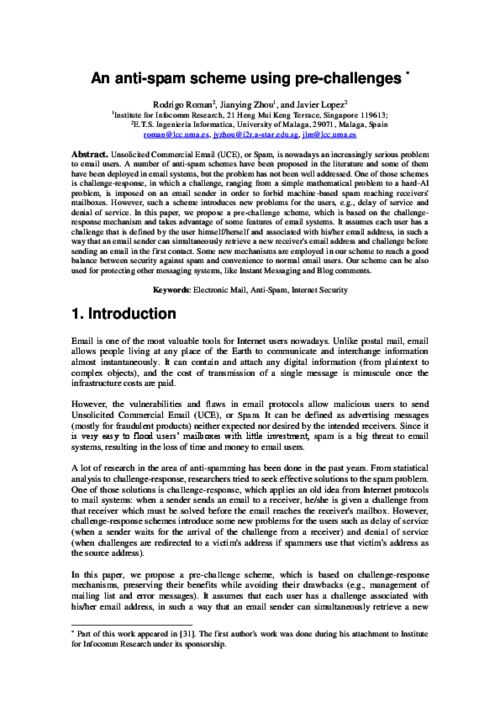
IEEE Consumer Communications & Networking Conference (CCNC 2006), IEEE, pp. 640-644, January, 2006. DOI
Abstract
The research of Intrusion Detection Systems (IDS) is a mature area in wired networks, and has also attracted many attentions in wireless ad hoc networks recently. Nevertheless, there is no previous work reported in the literature about IDS architectures in wireless sensor networks. In this paper, we discuss the general guidelines for applying IDS to static sensor networks, and introduce a novel technique to optimally watch over the communications of the sensors’ neighborhood on certain scenarios.
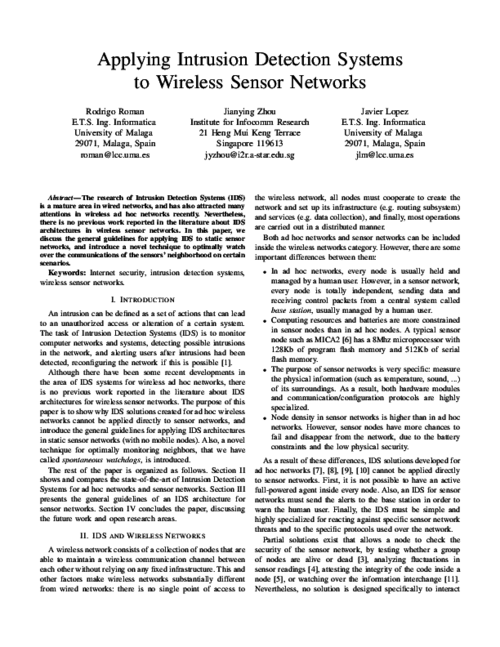
IX Reunion Española sobre Criptologia y Seguridad de la Informacion (RECSI’06), UOC S.L., pp. 129-141, 2006.
Abstract
Digital Rights Management (DRM) es un término general para cualesquiera de las soluciones que permite a un vendedor de contenido en forma electrónica controlar el material y restringir su uso de distintas maneras. Estas soluciones son posibles, por un lado gracias a técnicas de la Seguridad de la Información, principalmente cifrado de datos, y por otro a la distribución, de manera independiente, de contenido y derechos digitales. Esto permite que los consumidores puedan acceder libremente al contenido, pero sólo aquellos que adquieran el derecho digital apropiado (RO) podrán procesarlo. Como servicio de seguridad considerado en diversas capas del marco de seguridad definido por la recomendación ITU X.805, casi todas las aplicaciones necesitan considerar la propiedad de no repudio en las etapas iniciales de su diseño. Desafortunadamente, esto no ha sido así en general, y más concretamente en especificaciones DRM; debido a consideraciones en la práctica y al tipo de contenido a distribuir. Analizamos este servicio para un marco de DRM y proporcionamos una solución que permita que la adquisición de derechos digitales sea un operación que no pueda repudiarse.
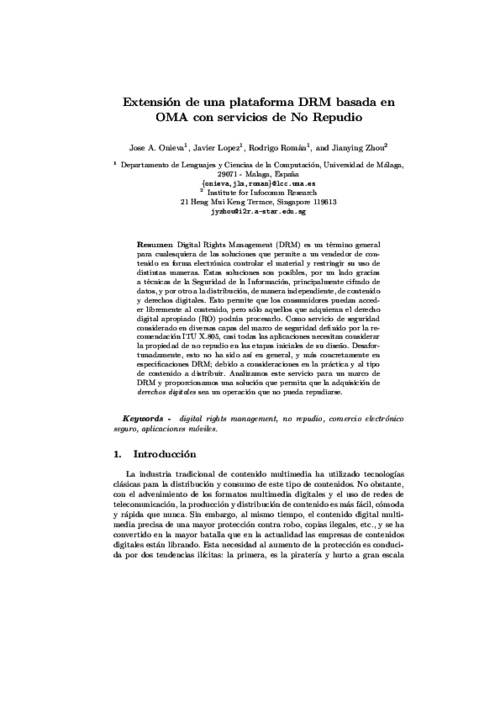
21st International Information Security Conference (IFIP SEC’06), no. 201, Springer, pp. 221-232, May, 2006.
Abstract
Contract signing is a fundamental service in doing business. The Internet has facilitated the electronic commerce, and it is necessary to find appropriate mechanisms for contract signing in the digital world. A number of two-party contract signing protocols have been proposed with various features. Nevertheless, in some applications, a contract may need to be signed by multiple parties. Less research has been done on multi-party contract signing. In this paper, we propose a new synchronous multi-party contract signing protocol that, with n parties, it reaches a lower bound of 3(n − 1) steps in the all-honest case and 4n − 2 steps in the worst case (i.e., all parties contact the trusted third party). This is so far the most efficient synchronous multi-party contract signing protocol in terms of the number of messages required. We further consider the additional features like timeliness and abuse-freeness in the improved version.
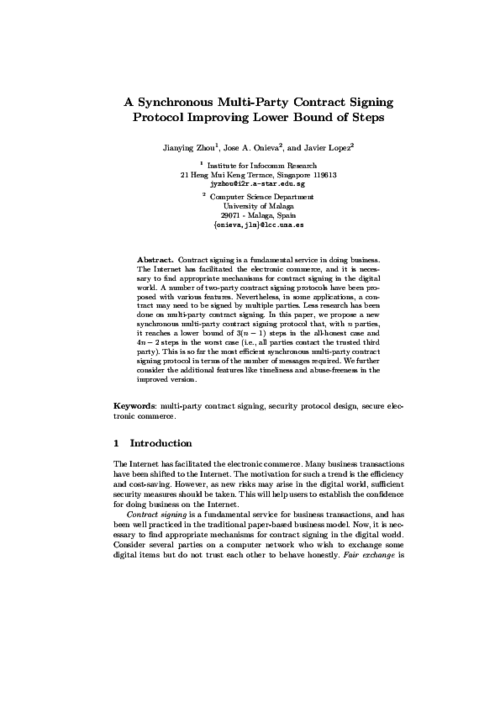
V Jornadas de Ingenería Telemática (JITEL’05), pp. 335-343, Septiembre, 2005.
Abstract
The design and development of security infrastructures and protocols for Wireless Sensor Networks is a difficult task, due to several factors like the constraints of the sensor nodes and the public nature of the communication channels. The intrinsic features of these networks create numerous security problems. In this paper, we analyze and put into perspective those problems.
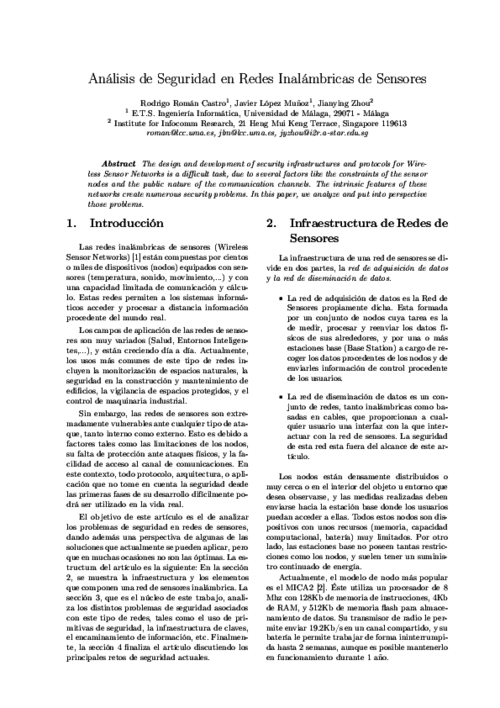
Simposio sobre Computación Ubicua e Inteligencia Ambiental (UCAmI’05), pp. 113-120, September, 2005.
Abstract
Los sistemas de detección de intrusiones (IDS) son una herramienta imprescindible de seguridad a la hora de proteger una red. Recientemente se han investigado y desarrollado arquitecturas de IDS para redes inalámbricas, en concreto para redes "Ad Hoc". No obstante, no existe un trabajo previo que desarrolle una arquitectura de IDS para una red de sensores. En este artículo, analizamos porque los sistemas IDS de redes "Ad Hoc" no pueden aplicarse a redes de sensores, e introducimos una arquitectura de IDS para redes de sensores que incorpora una nueva técnica para vigilar las comunicaciones de la red en ciertos escenarios.
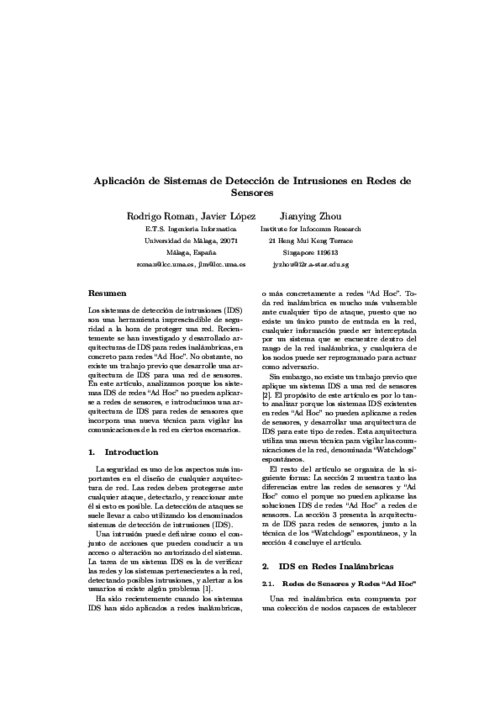
Proceedings of 6th International Conference on Cryptology in India, LNCS 3797, Springer, pp. 311–321, Decemeber, 2005.
Abstract
Contract signing is a fundamental service in doing business. The Internet has facilitated the electronic commerce, and it is necessary to find appropriate mechanisms for contract signing in the digital world. From a designing point of view, digital contract signing is a particular form of electronic fair exchange. Protocols for generic exchange of digital signatures exist. There are also specific protocols for two-party contract signing. Nevertheless, in some applications, a contract may need to be signed by multiple parties. Less research has been done on multi-party contract signing. In this paper, we analyze an optimistic N-party contract signing protocol, and point out its security problem, thus demonstrating further work needs to be done on the design and analysis of secure and optimistic multi-party contract signing protocols.
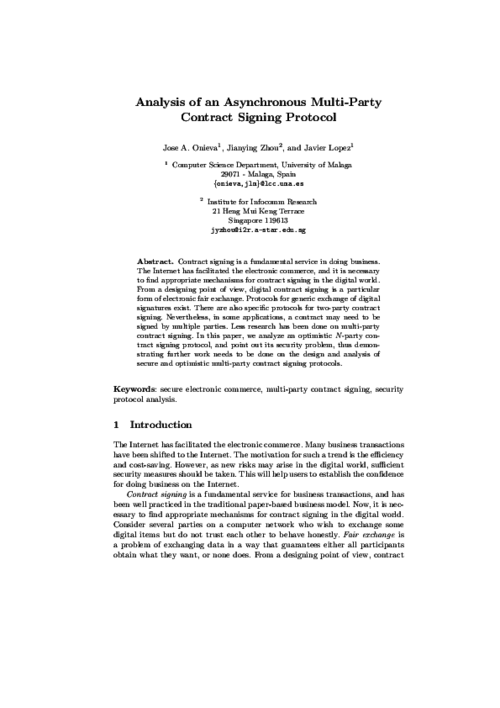
International Journal of Computer Systems Science & Engineering, vol. 3, CRL Publishing, pp. 185-192, 2005.
Abstract
Virtual Private Networks (VPNs) provide a cost-effective way for securing communications using public and insecure networks like the Internet. The main purpose of a VPN is to securely and transparently connect two or more remote networks to form virtually a single network, using centralized security policies for better management and protection. However, in certain scenarios, users may not require such a transparent access to the resources within their networks, but only want temporary secure access to internal services based on their own demands. We call the network architecture with such a feature as Casual VPN. In this paper, we present the notion of Casual VPN, and explain why traditional VPN architectures and protocols are unable to offer Casual VPN services. We also propose and define the operation of a particular Casual VPN architecture, C-VPN, which additionally allows the management of TCP and UDP-based protocols.
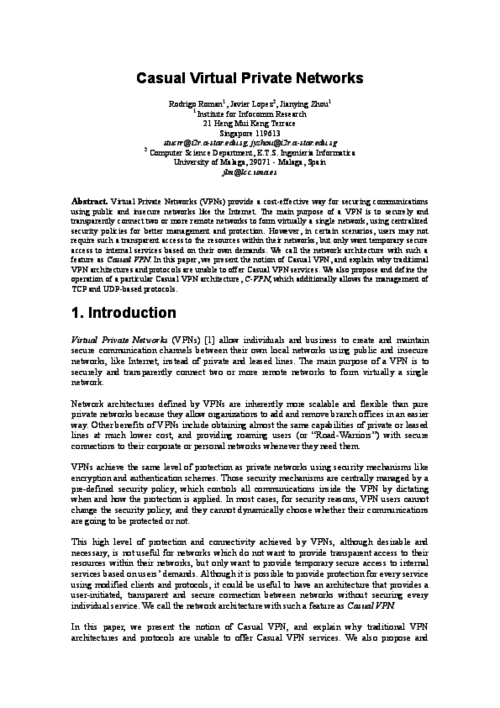
5th Symposium on Signal Processing and Information Technology (ISSPIT’05), IEEE, pp. 472-477, 2005.
Abstract
Digital Rights Management (DRM) is an umbrella term for any of several arrangements which allows a vendor of content in electronic form to control the material and restrict its usage in various ways that can be specified by the vendor. These arrangements are provided through security techniques, mainly encryption, and the distribution, in a detached manner, of content and rights. This allows free access to the content by the consumers, but only those carrying the proper Right Object (RO) will be able to process such content. As a security service considered in different layers of the security framework defined by ITU X.805, almost all applications need to consider non-repudiation in the very beginning of their design. Unfortunately this has not been done so far in DRM specifications due to practical issues and the type of content distributed. We analyze this service for the a DRM framework and provide a solution which allows the right objects acquisition to be undeniable.
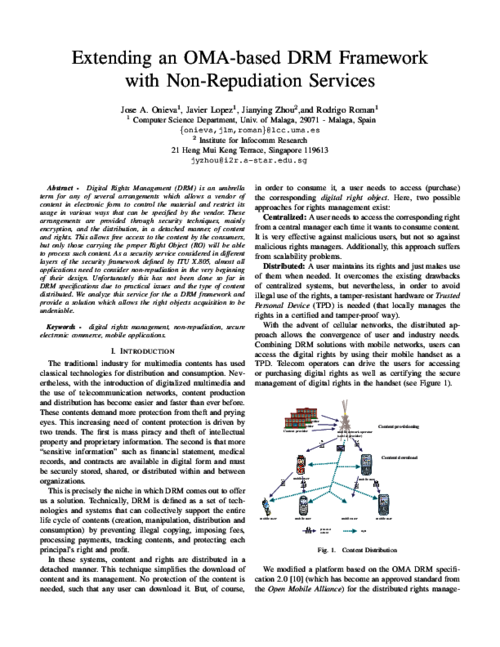
|
"Information Security, 8th International Conference, ISC 2005, Singapore, September 20-23, 2005, Proceedings", ISC, vol. 3650, Springer, 2005.  |  |
III Simposio Español de Comercio Electronico (SCE’05), Universitat de les Illes Balears, pp. 151-164, 2005.
Abstract
El no repudio es un requisito de seguridad cuya importancia se ha hecho evidente con el crecimiento del comercio electrónico. Muchos protocolos se han desarrollado como solución a este requisito. La gran mayoría incluye en su especificación parámetros cuyos valores no son fáciles de especificar pues dependen de las condiciones reales de implementación del mismo como los tiempos límites, las características de la TTP, tiempo de publicación de las claves, etc. En este trabajo proponemos un modelo que nos ayudará en la estimación de esos parámetros basado en la simulación del escenario real. Para la explicación y prueba del modelo mostramos un conjunto de experimentos.
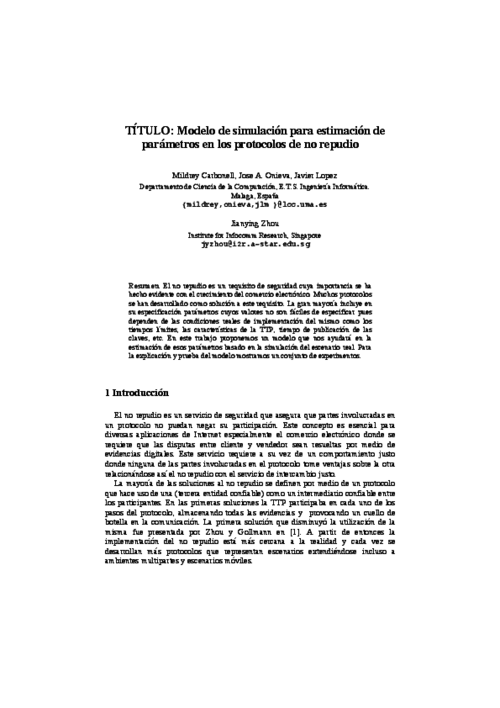
Information Management & Computer Security Journal, vol. 13, no. 5, pp. 350-366, 2005.
Abstract
As a value-added service to deliver important data over the Internet with guaranteed receipt for each successful delivery, certified email has been discussed for years and a number of research papers appeared in the literature. But most of them deal with the two-party scenarios, i.e., there are only one sender and one recipient. In some applications, however, the same certified message may need to be sent to a set of recipients. In this paper, we presents two optimized multi-party certified email protocols. They have three major features. (1) A sender could notify multiple recipients of the same information while only those recipients who acknowledged are able to get the information. (2) Both the sender and the recipients can end a protocol run at any time without breach of fairness. (3) The exchange protocols are optimized, each of which have only three steps.
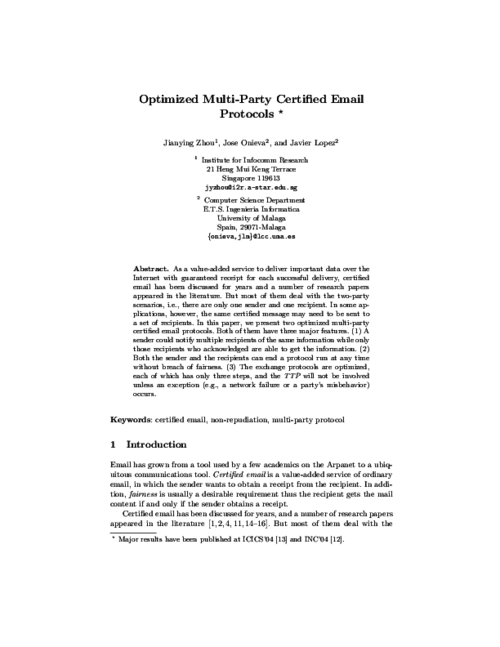
V Jornadas de Ingeniería Telemática (JITEL’05), pp. 375-382, September, 2005.
Abstract
Spam is considered to be one of the biggest problems in messaging systems. In the area of email Spam, A high number of anti-spam schemes have been proposed and deployed, but the problem has yet been well addressed. In this paper, we introduce a new scheme, called pre-challenge scheme, which avoids problems that exists in other schemes such as delay of service and denial of service. Some new mechanisms are employed to reach a good balance between security against Spam and convenience to email users. In addition, our scheme can be used for protecting other types of messaging systems, such as Instant Messaging (IM) and Blogs, against Spam.
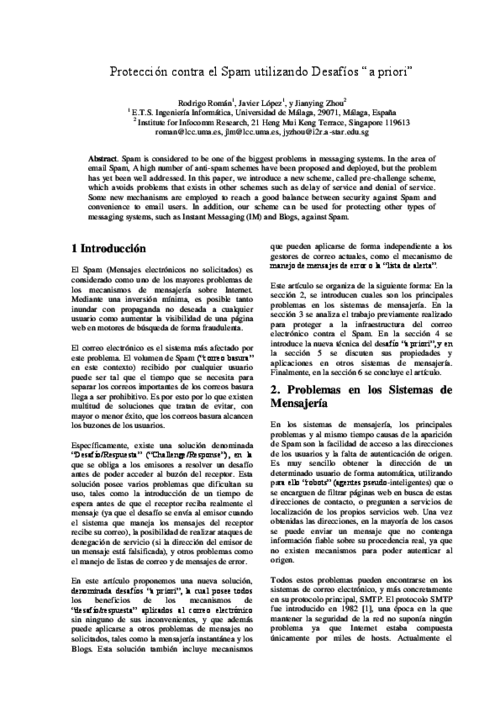
20th IFIP International Information Security Conference (IFIP-SEC’05), R. Sasaki, S. Qing, E. Okamoto, and H. Yoshiura Eds., Springer, pp. 281-294, May, 2005.
Abstract
Spam turns out to be an increasingly serious problem to email users. A number of anti-spam schemes have been proposed and deployed, but the problem has yet been well addressed. One of those schemes is challenge-response, in which a challenge is imposed on an email sender. However, such a scheme introduces new problems for the users, e.g., delay of service and denial of service attacks. In this paper, we introduce a pre-challenge scheme that avoids those problems. It assumes each user has a challenge that is defined by the user himself/herself and associated with his/her email address, in such a way that an email sender can simultaneously retrieve a new receiver’s email address and challenge before sending an email in the first contact. Some new mechanisms are employed to reach a good balance between security against spam and convenience to email users.
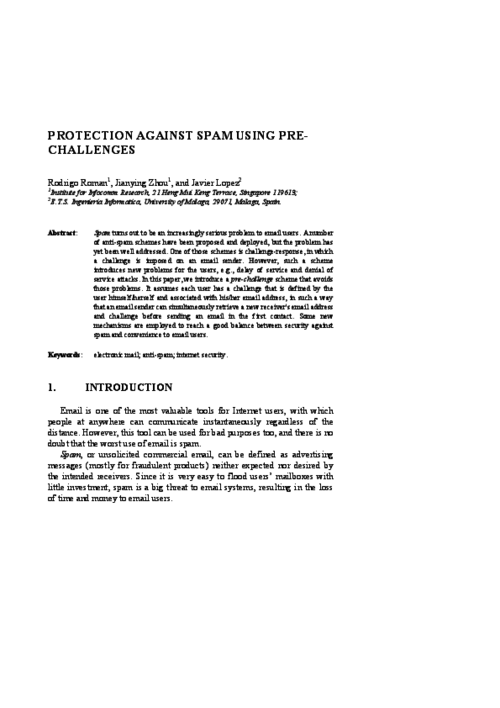
Computational Science and Its Applications (ICCSA’05), LNCS 3482, Springer, pp. 681-690, May, 2005. DOI
Abstract
Wireless Sensor Networks are extremely vulnerable against any kind of internal or external attacks, due to several factors such as resource-constrained nodes and lack of tamper-resistant packages. As a result, security must be an important factor to have in mind when designing the infrastructure and protocols of sensor networks. In this paper we survey the state-of-the-art security issues in sensor networks and highlight the open areas of research.security issues in sensor networks and highlight the open areas of research.
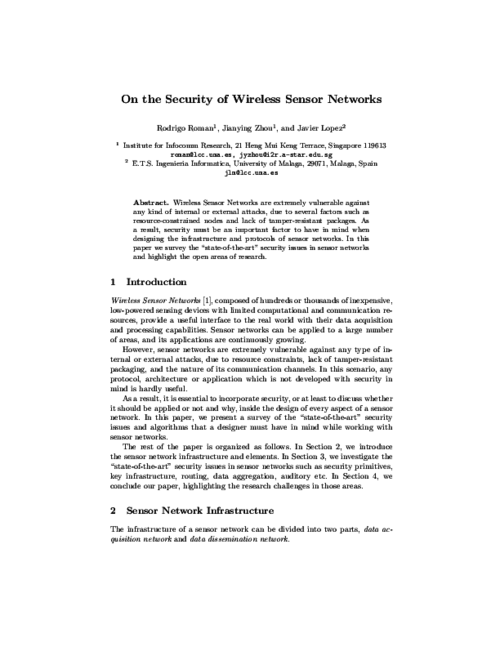
Electronic Commerce Research and Applications, vol. 3, no. 2, Elsevier, pp. 152-162, 2004.
Abstract
Non-repudiation is a security service that provides cryptographic evidence to support the settlement of disputes in electronic commerce. In commercial transactions, an intermediary (or agent) might be involved to help transacting parties to conduct their business. Nevertheless, such an intermediary may not be fully trusted. In this paper, we propose agent-mediated non-repudiation protocols and analyze their security requirements. We first present a simple scenario with only one recipient, followed by a more complicated framework where multiple recipients are involved and collusion between them is possible. We also identify applications that could take advantage of these agent-mediated non-repudiation protocols.
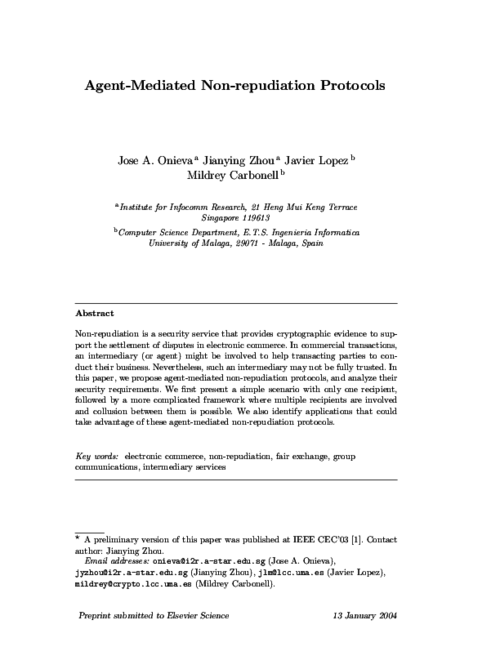
6th Conference on E-Commerce (CEC’04), IEEE Computer Society, pp. 221-226, June, 2004.
Abstract
Mobile agents play an important role in electronic commerce. Security in free-roaming agents is especially hard to achieve when the mobile code is executed in hosts that may behave maliciously. Some schemes have been proposed to protect agent data (or computation results). However, a known vulnerability of these techniques is the truncation attack where two visited hosts (or one revisited host) can collude to discard the partial results collected between their respective visits. Cheng and Wei proposed a scheme in ICICS’02 to defense against the truncation of computation results of free-roaming agents. Cheng-Wei scheme is effective against such an attack in most cases. However, we demonstrate that it still suffers from the truncation attack when a special loop is established on the path of a free-roaming agent. We further propose two amendments to Cheng-Wei scheme to avoid such an attack.
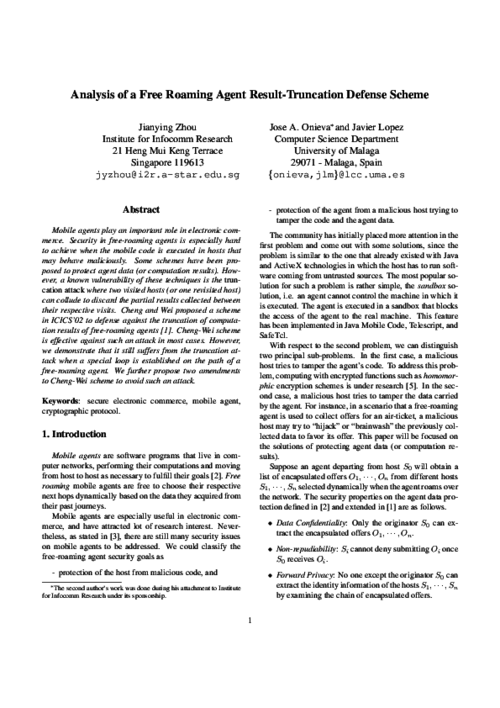
Fourth International Network Conference, University of Plymouth, pp. 327-335, 2004.
Abstract
Certified email is a value-added service of ordinary email, in which a sender wants to obtain a receipt from a recipient. Fair exchange protocols are a key component for certified email service to ensure fairness, i.e., the items held by two parties are exchanged without one party obtaining an advantage. We can find in the literature simple and fast optimistic protocols for fair electronic exchange and, more specifically, for certified electronic mail (CEM) and electronic contract signing (ECS). We have observed that some aspects of those protocols could be substantially improved. This paper presents two major contributions. Firstly, we provide a solution that allows both parties to end the protocol timely in an asynchronous way. Then, we extend the certified email service to the multicast scenario.
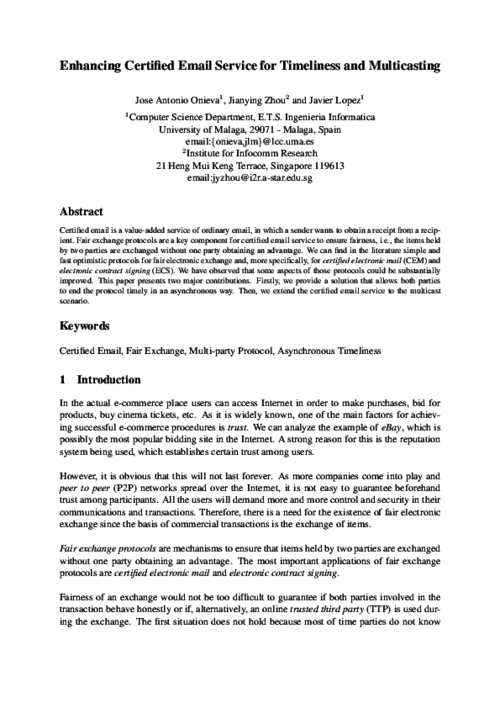
VIII Reunión Española sobre Criptología y Seguridad de la información (RECSI’04). Avances en Criptologia y Seguridad de la Informacion, Diaz de Santos, pp. 537-546, 2004.
Abstract
El correo electrónico certificado es un servicio añadido al correo electrónico estándar, en el cual el remitente desea obtener un recibo procedente del destinatario. Para este servicio, encontramos que los protocolos de intercambio (justo) son un componente principal para asegurar la corrección en la ejecución de los servicios de correo electrónico certificado, ya que los ítems que ambas partes presentan (en este caso específico, el mensaje de correo y el recibo del mismo) deben ser intercambiados sin que ninguna de las partes obtenga una ventaja durante el proceso sobre la otra. Podemos encontrar en esta línea de investigación protocolos optimistas eficientes para el intercambio electrónico, y mas concretamente para Correo Electrónico Certificado (CEC) y Firma Electrónica de Contratos (FEC). Realizando un estudio adecuado hemos observado que algunos aspectos de dichos protocolos podrían ser mejorados. En este artículo proponemos una solución que permite a ambas entidades terminar el protocolo de forma asíncrona. También extendemos el protocolo a múltiples usuarios.
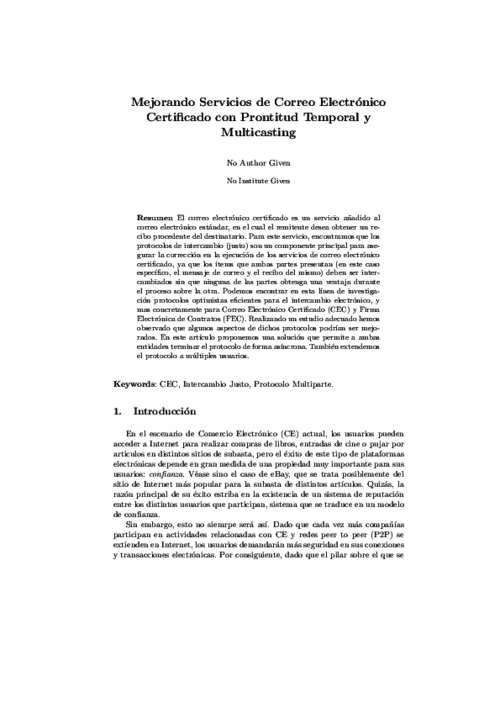
Computer Communications, vol. 27, no. 16, pp. 1608-1616, 2004.
Abstract
Non-repudiation is a security service that provides cryptographic evidence to support the settlement of disputes. In this paper, we introduce the state-of-the-art of non-repudiation protocols for multiple entities. We extend an existing multi-party non-repudiation (MPNR) protocol to allow an originator to send different messages to many recipients in a single transaction. We further propose an optimistic multi-party non-repudiation protocol for exchange of different messages. The performance of our protocols with enhanced functionalities is still promising in comparison with existing MPNR protocols.
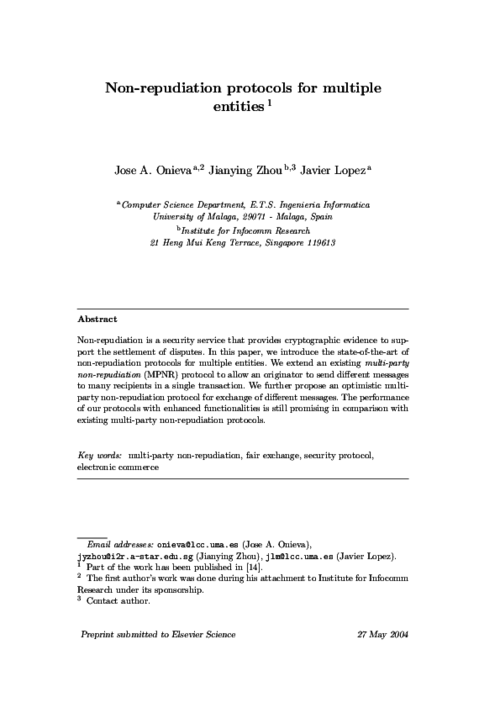
60th IEEE Vehicular Technology Conference (VTC’04), IEEE Vehicular Technology Society Press, pp. 3271-3274, 2004.
Abstract
Mobile agents are especially useful in electronic commerce, for both wired and wireless environments. Nevertheless, there are still many security issues on mobile agents to be addressed, for example, data confidentiality, non-repudiability, forward privacy, publicly verifiable forward integrity, insertion defense, truncation defense, etc. One of the hardest security problems for free roaming agents is truncation defense where two visited hosts (or one revisited host) can collude to discard the partial results collected between their respective visits. We present a new scheme satisfying those security requirements, especially protecting free roaming agents against result-truncation attack.
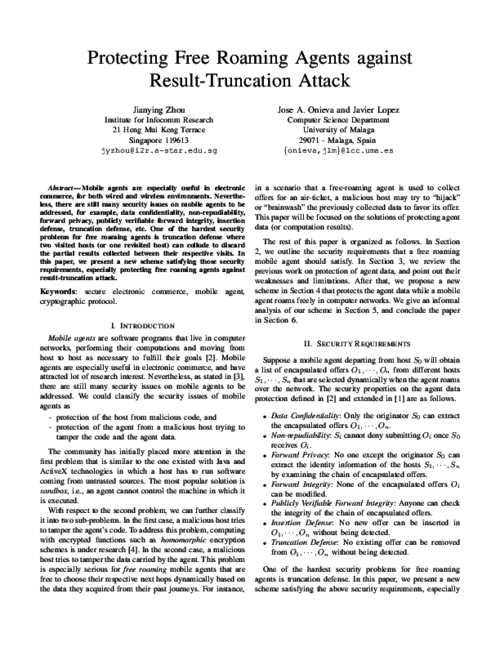
2nd Workshop on Internet Communications Security (WICS’04), (within Computational Science and its Applications International Conference), LNCS 3043, Springer, pp. 903-914, May, 2004.
Abstract
An essential issue for the best operation of non-repudiation protocols is to figure out their timeouts. In this paper, we propose a simulation model for this purpose since timeouts depend on specific scenario features such as network speed, TTP characteristics, number of originators and recipients, etc. Based on a one-to-many Markowicth’s protocol simulation model as a specific example, we have worked out various simulation experiments.
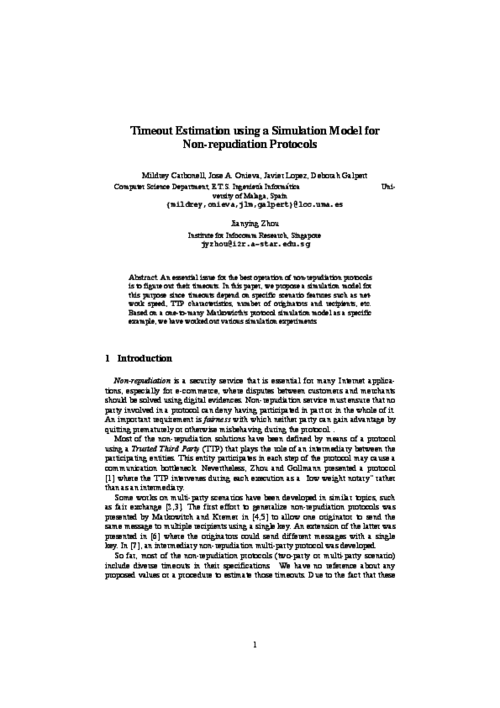
5th Conference on Electronic Commerce, IEEE Computer Society, pp. 207-214, June, 2003.
Abstract
n commercial transactions, an intermediary might be involved to help transacting parties to conduct their business. Nevertheless, the intermediary may not be fully trusted. In this paper, we introduce the concept of intermediary (or agent) in a non-repudiation protocol, define the aims of intermediary non-repudiation protocols, and analyze their security requirements. We present a simple scenario with only one recipient, followed by a more complicated framework where multiple recipients are involved and collusion between them is possible.
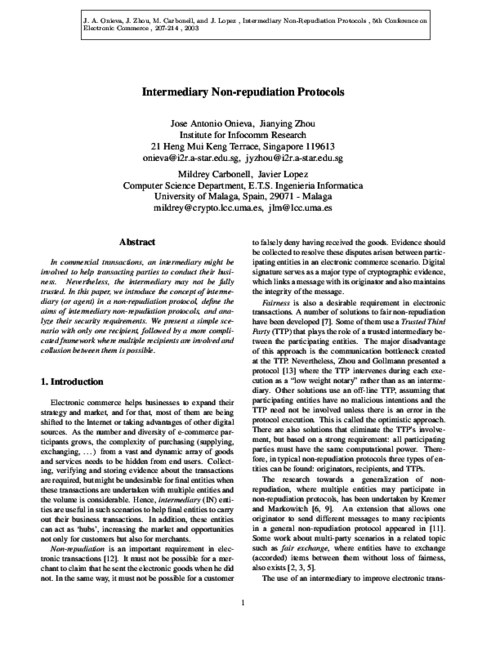
18th IFIP International Information Security Conference. Security and Privacy in the Age of Uncertainty (IFIP SEC’03), IFIP, pp. 37-48, May, 2003.
Abstract
Non-repudiation is a security service that provides cryptographic evidence to support the settlement of disputes. In this paper, we introduce the state-of-the-art of multi-party non-repudiation protocols, and analyze the previous work where one originator is able to send the same message to many recipients. We propose a new multi-party non-repudiation protocol for sending different messages to many recipients. We also discuss the improvements achieved with respect to the multiple instances of a two-party non-repudiation protocol, and present some applications that would benefit from them.
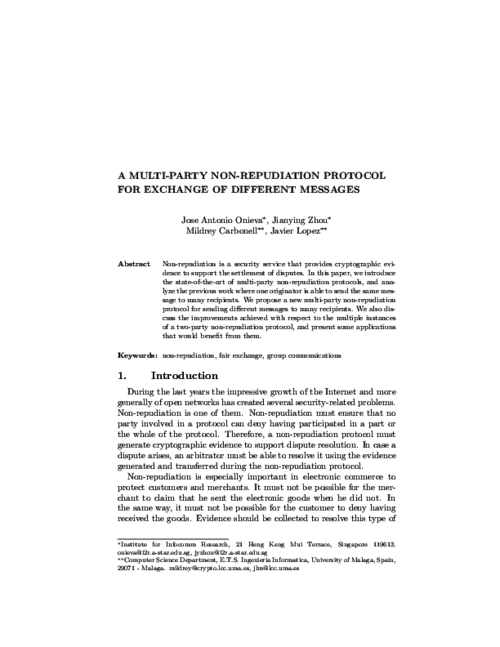
Fifth International Conference on Information and Communications Security, LNCS 2836, Springer, pp. 112 - 123, October, 2003.
Abstract
With emerging decentralized technologies, peer-to-peer (P2P) content distribution arises as a new model for storage and transmission of data. In this scenario, one peer can be playing different roles, either as a distributor or as a receiver of digital contents. In order to incentivize the legal distribution of these contents and prevent the network from free riders, we propose a charging model where distributors become merchants and receivers become customers. To help in the advertisement of digital contents and collection of payment details, an intermediary agent is introduced. An underlying P2P payment protocol presented in [1] is applied to this scenario without total trust on the intermediary agent.
